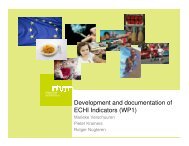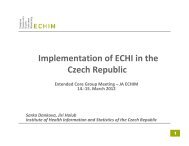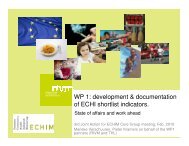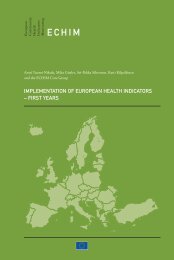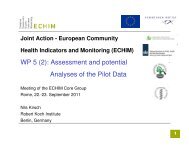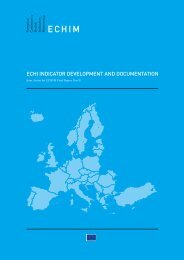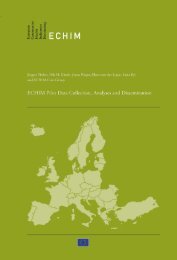INDICATORS
ECHIM Final Report
ECHIM Final Report
You also want an ePaper? Increase the reach of your titles
YUMPU automatically turns print PDFs into web optimized ePapers that Google loves.
Calculation:<br />
1) An index or a score indicating psychological well-being, derived from the EHIS questions<br />
SF.2–SF.10: How much of the time, during the past 4 weeks: SF.2 Did you feel full of life?<br />
SF.6 Did you have a lot of energy? SF.8 Did you feel worn out? SF.10 Did you feel tired?<br />
The five response categories are: 1. All of the time; 2. Most of the time; 3. Some of the time;<br />
4. A little of the time; 5. None of the time. The precise operationlisation to be defined later.<br />
2) Recommendation by Mindful/Working Party Mental Health: a mean score of 62 or less<br />
on the Energy and Vitality Index (EVI) score (from the RAND Short Form 36 (SF–36 v1.0)<br />
questionnaire) is taken to indicate Psychological well-being. Energy and Vitality Index score<br />
is based on the following four questions: How much time during the past month? 1. Did<br />
you feel full of life? 2. Did you have lots of energy? 3. Did you feel worn out? 4. Did you feel<br />
tired? The six response categories are: 1. All of the time; 2. Most of the time; 3. A good bit of<br />
the time; 4. Some of the time; 5. A little of the time; 6. None of the time. The score for the<br />
MHI-5 is computed by adding the scores of each question item and then transforming the<br />
raw scores to a 0–100-point scale.<br />
Notes: The Energy and vitality index (EVI) one of the eight scales that constitute the SF-<br />
36. It has a score of 0 to 100, where a score of 100 represents optimal mental health. The<br />
suggested population norm for the mean score is 70 and 62 for the cut-point (MINDFUL).<br />
The EHIS questions SF.2–SF.10 differ slightly from the questions of the original The Energy<br />
and vitality index (EVI). Thus the scoring of MHI-5 defined in calculation (2) may not be<br />
applied as such. The same applies also to the Special Eurobarometer survey 248 on Mental<br />
Well-Being, question QA5..<br />
40. HEALTH EXPECTANCY: HEALTHY LIFE YEARS (HLY)<br />
Definition: Eurostat structural indicator defined as expected remaining years lived at a<br />
particular age without long-term activity limitation. It is computed by the Sullivan method<br />
based on life table data and the Euro-REVES General Activity Limitation Indicator (GALI).<br />
Calculation: Computed by the Sullivan method: life tables combined with age-specific<br />
period prevalence data on long-term activity limitations (Documentation Sheet 34):<br />
Prevalence of persons who answer “severely limited” or “limited but not severely” to the<br />
EHIS question HS.3.: “For at least the past 6 months, to what extent you have been limited<br />
because of a health problem in activities people usually do? Severely limited / limited but not<br />
severely / not limited at all.”<br />
Notes: Healthy Life Years can also be called “Life expectancy without activity limitations”,<br />
and belongs under the more general concept of “Health Expectancy”. It is one specific<br />
health expectancy and others can be calculated based on for example self perceived health<br />
or self-reported chronic morbidity. Healthy Life Years is a different concept to the Health-<br />
Adjusted Life Expectancy (HALE, number of expected years of life equivalent to years lived<br />
in full health) or Disability-Adjusted Life Expectancy (DALE, which use disability weights in<br />
the calculation, thus part of the life expectancy with disability is added to disability free life<br />
expectancy to obtain the latter), which are based on quite different premises and calculations.<br />
HLY is one of the Eurostat structural indicators.<br />
107



